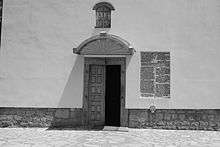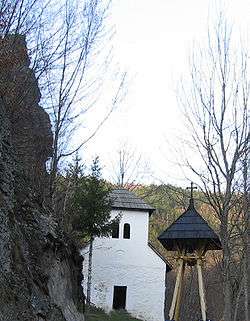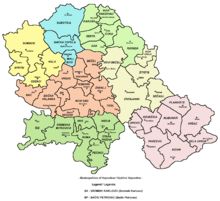Ivanjica
| Ivanjica Ивањица | ||
|---|---|---|
| Municipality and Town | ||
|
Town center | ||
| ||
 Location of the municipality of Ivanjica within Serbia | ||
| Coordinates: 43°34′52″N 20°13′47″E / 43.58111°N 20.22972°ECoordinates: 43°34′52″N 20°13′47″E / 43.58111°N 20.22972°E | ||
| Country | Serbia | |
| District | Moravica District | |
| Settlements | 49 | |
| Government | ||
| • Mayor | Zoran Lazović | |
| Area | ||
| • Municipality and Town | 1,090 km2 (420 sq mi) | |
| Elevation | 468 m (1,535 ft) | |
| Population (2011) | ||
| • Municipality and Town | 31,963 | |
| • Density | 29/km2 (76/sq mi) | |
| • Urban | 11,715 | |
| Time zone | CET (UTC+1) | |
| • Summer (DST) | CEST (UTC+2) | |
| Postal code | 32250 | |
| Area code(s) | 032 | |
| Vehicle registration | IC | |
| Website | ivanjica.rs | |
Ivanjica (Serbian Cyrillic: Ивањица, pronounced [ǐʋaɲitsa]) is a town and municipality located in central Serbia. The population of the town is 11,715, while the population of the municipality is 31,963.
The town is famous for having large potato and raspberry plantations in which many locals are employed. It is also known for the cultural event Nušićijada and as being the birthplace of World War II Chetnik leader, Draža Mihailović.
Geography
Ivanjica lies in the southwest of Serbia. It lies at the bank of the Moravica River. It is surrounded by the mountain ranges of Golija, Javor, Mučanj, Čemerno and Radočelo and it is placed in a picturesque valley.
The municipality to the Moravica District together with the municipalities of Lučani, Čačak and Gornji Milanovac. With an area of 1090 km², it is the sixth largest municipality in Serbia. Ivanjica got the status of a town in 1866 through the Prince Mihailo Obrenović’s decree, thus becoming one of the first towns in the region.
Mountains are the dominant form of relief in this area and they belong to the Dinaric range. They are rich in forests, clearings, pastures, cold springs, clear rivers and clear air, wild fruit, medicinal herbs and various game.
The river system of the municipality and its neighbourhood is made up of clear, clean and unpolluted fast mountain rivers: the Moravica, the Studenica and the Nošnica which, together with their tributaries, curve down the Moravica mountains. There are and two small lakes: Nebeska Suza and Tičar Lake.[1]
History
Ivanjica has gained the status of the town in 1833, after the Prince of Serbia, Miloš Obrenović took the area.[2]
Today, after all the wars, suffering, displacing and migrations, Ivanjica is a modern little town and the municipality with around 32,000 citizens. It is the economic, cultural, administrative and health care centre of the municipality. Its development is based on agriculture and tourism as two main bearers of prosperity.[3]
Economy
The municipality of Ivanjica lies in an economically underdeveloped part of Serbia, with the level of GDP in the range of 60% to 80% of the national average.[4] The economy of Ivanjica Municipality is typified by the processing industry, lumber processing, production of textile products and production of raspberry and potato. Coverage of imports by exports is 92%.
There are 362 active enterprises in the municipality of Ivanjica. Small enterprises make 95% of the total number of enterprises.[5]
Buildings
- The Old Bazaar (Serbian Cyrillic: Stara čaršija) in Ivanjica is the name for the center of the town, which was declared good for a remarkable stationary culture in 1987.[6] The center of the town, especially the main street, Milinka Kušića, retains its authentic appearance dating back to the middle of the 19th century. Most of the structures were built after the Great Fire in 1846, which burned the town to the ground which was stopped after some houses where blown up to prevent spread.[7] Old Bazaar was used for a decades as backdrop for making movies and TV shows in the golden age of Yugoslavian cinematography. Promotion of the Old Bazaar as a place for making films started with Soja Jovanović making the first version of Branislav Nušić's Sumnjivo lice, in the 1950s. Later Zdravko Šotra made the TV show Više od igre, and after that, the movies Sok od šljiva, Užička republika and so on. For this film era authentic ambiance of a town from the 19th century was desirable, so Ivanjica was named "Little Hollywood".
- One of the oldest structures in the Old Bazaar is the Jeremić House, a two-floor building that was one of the twelve buildings saved after fire. The ground floor used to be a manufacturing workshop, while the upper floor functioned as a living space. It is located at the end of boulevard and is one of the symbols of Ivanjica.

- Immediately after the town was founded, around 1836, construction started of a town church which was aided by donations from locals. The Church of Saint Emperor Konstantin and Empress Jelena was constructed in three years. The first restoration of the church was in the 1850s, and a famous artist from the time period, Dimitrije Posniković, painted it in 1862. Authentic iconostases were saved and remain even today.

- At the end of the 19th century a single-arched bridge was constructed. It is known today as the Stone Bridge. The project was signed by engineer Milenko Trudić, and construction work was entrusted to Blagoje Luković from Ivanjica. Stone for the construction was transported from a mine in Rašići. According to local stories, a lack of cement called for the use of 30 thousand chicken eggs to keep the stones together. At the time it was the only single-arched bridge in that part of the Balkans, for which a crossed-wedges system of construction was used. The length of the arches which connect the two coasts is 25 meters. During construction four people lost their lives. In their honor, a monument was built in Ivanjica cemetery. Bridge construction ended in 1906.
- In the area of the Old Bazaar there is also the Kušića han. This object is a symbol of the rural construction of the Moravička area. It is built in mountain style from wood and stone. It used to be a doss-house for travelling traders, which were passing through on the way from Sandžak and Zlatibor.
- Across from the Kušića han is the Monument of Revolution. The author of this monument is Yugoslav painter Đorđe Andrejević Kun, who was aided by Nada Hude, Miloš Gvozdenović and Ljuba Lah. Records about these artists were saved on a panel on the north side of the monument. The monument is shaped in a slightly curved semi-cylindrical reversed trapeze. It is installed on a rectangular pedestal made from white marble.On the front side there is a mosaic illustration of revolutionaries in a battle storm, made from small ceramic panels. From each side there are marble planters. The mosaic does not contain written epitaph, only an engraved inscription in marble "1941-1945". The monument was reviewed in 1957.[8]
- Another part of the town are also the Moravica Hydro power plants, built in 1911. It started working as the ninth hydro power plant in Serbia. Hydro power plants had 260 hp and illuminated only the town. Siemens generator was transported in Ivanjica on steer harness, which has no railway even today. In 1936, a concrete breakwater was built 9m height and 25m width. In 2011 the appearance of the hydro-power plants was changed, with a view of a waterfall which attracted visitors to the area.
Cultural events
The bearers of cultural development in the Municipality of Ivanjica are numerous institutions and organizations. The leading role among them belongs to the Ivanjica Culture Centre and the Svetislav Vulović Library.
Some of Cultural events are: Hunters’ Fair and Wolf Hunt, Parade of Folk Creative Work - Sounds of Golija, Motorcycle Meetings in Ivanjica, Most Beautiful Love Poem Competition, If May Were All the Time, Parade of Reciters and many others.
In 2010, cultural event Nušićijada is renewed by initiative of Cultural Artistic Society "Dom Kulture" from Ivanjica.[9] This is specific cultural Festival inwrought with humor, entertainment, old town spirit returns to the scene after 40 years.
Tourism
The beginnings of the development of tourism in Ivanjica Municipality are connected with the 1930s when Ivanjica was proclaimed to be a spa and a climatic place.
Tourist charm of Ivanjica Municipality is based on its rich natural and cultural resources, long history and tradition, specific identity of numerous sites and cordiality of Ivanjica’s hosts. Ivanjica has numerous possibilities for the development of all kinds of tourism: medical, village, sports, hunting and fishing, excursion, congress, and festival and event tourism. This municipality was proclaimed to be the first air spa in Serbia in 2000, while Golija Mountain is Biosphere reserve under the UNESCO protection. As far as the available accommodation capacities are concerned, the municipality has around 1000 beds in classified facilities and around 200 beds in village households, in the town and in the suburbs.
The biggest Health Care Center in Ivanjica is the Institute for Specialized Rehabilitation operates as a state institution which has both medical and tourist character. Its basic activity is medical rehabilitation and provision of services based on recreational medical tourism.[10]
Sport
There are 28 sports clubs in the Municipality of Ivanjica. The dominant sports are football, basketball, volleyball, archery and winter sports. According to results, the most successful sport club is a football club FK Javor Ivanjica, which was founded in 1912. In 2012 this football club was celebrating its centenary from club founding.[11] This club was a continuous member of the First League for the last several years. Other popular sport clubs are OK Putevi volleyball club and KK Ivanjica basketball club, playing in the lower, regional leagues of Western Serbia.
On the territory of Ivanjica Municipality there are 6 football fields, 2 indoor swimming pools, 2 outdoor swimming pools, 3 gyms, one air rifle range, 29 outdoor fields for recreation, one athletics track, one chess hall and 2 sports halls.[12]
Famous people from Ivanjica
- Dragoljub Mihailović as an officer of the Royal Yugoslav Armed Forces categorically refused to surrender, continued actively fighting the Nazis after the invasion of Yugoslavia in April 1941. Tragically, however, he was betrayed by the Anglo-American Alliance. He saved downed U.S., British, Russian, French, and Canadian airmen over the Serbian territory during World War II. Many books have been written about him, including a Hollywood film was made during the war entitled "The Chetniks!"
Gallery
 The Stone bridge
The Stone bridge- View on the old hydroelectric power plant from the restaurant
 The old hydroelectric power plant
The old hydroelectric power plant Kovilje Monastery
Kovilje Monastery- View on Ivanjica in the winter
- Road entry to the town center
- Roundabout in the winter
 Stadion Ivanjica
Stadion Ivanjica Landscape of Ivanjica municipality
Landscape of Ivanjica municipality Panorama of Ivanjica
Panorama of Ivanjica Panorama of Ivanjica
Panorama of Ivanjica
Demographics
According to the latest official census done in 2011, the Municipality of Ivanjica had 31,963 inhabitants. Most of Ivanjica’s population is of Serbian nationality (98.6%), while the 63.3% of the municipality’s population is living in rural areas. Depopulation is typical for villages because of the migrations to urban and other areas. Population density of the municipality is 29.3 inhabitants per square kilometer. The percentage of the population with the university education is 4 percent. The Municipality of Ivanjica has 10,388 households with 3,03 members on average, while the number of homes is 13,469.
Ethnic composition
The ethnic composition of the municipality:
| Ethnic group | Population 1948[13] |
Population 1953[14] |
Population 1961[15] |
Population 1971[16] |
Population 1981[17] |
Population 1991[18] |
Population 2002[19] |
Population 2011[20] |
|---|---|---|---|---|---|---|---|---|
| Serbs | 32,597 | 36,154 | 34,161 | 38,919 | 37,331 | 36,111 | 35,021 | 31,507 |
| Romani | - | - | 2 | 1 | 10 | 8 | 33 | 29 |
| Montenegrins | 19 | 69 | 41 | 65 | 79 | 134 | 68 | 24 |
| Albanians | - | 9 | 10 | 13 | 16 | - | - | 13 |
| Macedonians | 8 | 14 | 15 | 17 | 21 | - | 12 | 13 |
| Croats | 13 | 43 | 11 | 12 | 24 | 12 | 9 | 9 |
| Muslims | 1 | - | 3 | 12 | 5 | 11 | 6 | 8 |
| Gorani | - | - | - | - | - | - | 7 | 7 |
| Yugoslavs | - | 2 | 1 | 20 | 265 | 245 | 32 | 7 |
| Others | 159 | 29 | 47 | 174 | 136 | 286 | 257 | 346 |
| Total | 32,797 | 36,320 | 34,291 | 39,233 | 37,887 | 36,686 | 35,445 | 31,963 |
Notable residents
- Draža Mihailović, leader of Chetnik movement
- Petar Stambolić, Serbian politician
- Ivan Stambolić, Serbian politician
- Vladica Kovačević, Serbian footballer
- Srboljub Krivokuća, Serbian footballer
- Petar Krivokuća, Serbian footballer
- Tomislav Ladan, Croatian essayist
- Miljan Mutavdžić, Serbian footballer
- Milovan Milović, Serbian footballer
- Radovan Ćurčić, Serbian football coach
See also
References
- ↑ https://web.archive.org/web/20120304223616/http://www.ivanjica.rs/english/index.php?option=com_content&view=article&id=43:position&catid=23:example-category&Itemid=57. Archived from the original on March 4, 2012. Retrieved February 18, 2016. Missing or empty
|title=(help) - ↑ "Ivanjica: The beauty of tranquility". b92.net. Retrieved 1 September 2013.
- ↑ https://web.archive.org/web/20120304223607/http://www.ivanjica.rs/english/index.php?option=com_content&view=article&id=48:history-of-moravica-region&catid=24:example-category&Itemid=67. Archived from the original on March 4, 2012. Retrieved February 18, 2016. Missing or empty
|title=(help) - ↑ "Stepen razvijenosti za 2014. godinu". regionalnirazvoj.gov.rs (in Serbian). Retrieved 26 September 2015.
- ↑ "Privreda". ivanjica.gov.rs (in Serbian). Retrieved 26 September 2015.
- ↑ "Official website of Municipality of Ivanica". Retrieved 9 May 2014.
- ↑ "Cultural monuments of Serbia". Retrieved 11 May 2014.
- ↑ "Tourist Organisation of Ivanjica". Retrieved 10 May 2014.
- ↑ "Humor, zabava, starogradski duh - Danas". Naslovi.net. 2010-08-30. Retrieved 2015-06-10.
- ↑ https://web.archive.org/web/20120304223653/http://www.ivanjica.rs/english/index.php?option=com_content&view=article&id=52&Itemid=74. Archived from the original on March 4, 2012. Retrieved February 18, 2016. Missing or empty
|title=(help) - ↑ "FK Javor iz Ivanjice slavi 100. rođendan". 24sata.rs (in Serbian). 23 August 2012. Retrieved 14 August 2015.
- ↑ Archived October 17, 2010, at the Wayback Machine.
- ↑ "STALNO STANOVNISTVO PO NARODNOSTI" (PDF). stat.gov.rs. Republički zavod za statistiku. Retrieved 4 March 2015.
- ↑ "UKUPNO STANOVNIŠTVO PO NARODNOSTI (1953)" (PDF). stat.gov.rs. Republički zavod za statistiku. Retrieved 3 March 2015.
- ↑ "Knjiga III: Nacionalni sastav stanovništva FNR Jugoslavije (1961)" (PDF). stat.gov.rs (in Serbian). Republički zavod za statistiku. Retrieved 3 March 2015.
- ↑ "Knjiga III: Nacionalni sastav stanovništva FNR Jugoslavije (1971)" (PDF). stat.gov.rs (in Serbian). Republički zavod za statistiku. Retrieved 3 March 2015.
- ↑ "Nacionalni sastav stanovništva SFR Jugoslavije (1981)" (PDF). stat.gov.rs. Republički zavod za statistiku. Retrieved 3 March 2015.
- ↑ "STANOVNIŠTVO PREMA NACIONALNOJ PRIPADNOSTI (1991)" (PDF). stat.gov.rs. Republički zavod za statistiku. Retrieved 3 March 2015.
- ↑ "Popis stanovnistva, domacinstava i stanova u 2002" (PDF). stat.gov.rs (in Serbian). Retrieved 3 March 2015.
- ↑ "Попис становништва, домаћинстава и станова 2011. у Републици Србији" (PDF). stat.gov.rs. Republički zavod za statistiku. Retrieved 3 March 2015.
External links
| Wikimedia Commons has media related to Ivanjica. |
- Official website
- Tourism Organisation of Ivanjica (Serbian)
- Ivanjički radio (Serbian)




